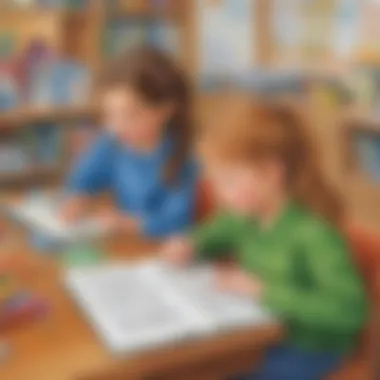Unlocking the Potential: The Vital Role of Phonics in Elementary Education


Creative Activities
Elementary education lays the groundwork for effective literacy skills, with phonics playing a crucial role in this developmental process. Young learners often benefit from engaging in hands-on creative activities that reinforce phonemic awareness and decoding skills. One effective way to facilitate this learning is through craft ideas tailored to their interests and abilities. By incorporating materials readily available at home or school, such as colored paper, markers, and glue, children can create visual representations of phonemes and words. These craft sessions not only enhance fine motor skills but also help solidify the connection between sounds and letters. Step-by-step guides accompanying each activity ensure clear instructions for teachers, students, and parents. Furthermore, discussions on the educational value of such projects emphasize the direct link between these creative exercises and improved reading comprehension and spelling proficiency.
Fun Quizzes
Supplementing traditional phonics instruction with interactive quizzes can invigorate learning experiences and promote deeper understanding among elementary school children. Quiz topics can encompass various phonics rules, sight words, and word families, offering a comprehensive review of key concepts. Through a diverse range of question types, including multiple-choice, fill-in-the-blank, and matching exercises, quizzes cater to different learning styles and abilities, fostering engagement and cognitive growth. These quizzes serve as effective tools for knowledge reinforcement, encouraging students to apply newly acquired phonics skills in practical contexts. By encouraging friendly competition or group activities based on quiz results, educators can further enhance retention and motivation among young learners.
Fact-Based Articles
Incorporating fact-based articles into phonics instruction adds depth to the learning experience and expands students' knowledge base. Covering a myriad of topics related to language development, reading strategies, and literary genres, these articles provide invaluable insights for elementary students seeking to master phonics. The engaging content structure ensures that information is presented in a lucid and accessible manner, making complex phonics concepts easier to comprehend. Additionally, including interactive elements within the articles, such as embedded videos or interactive exercises, can enhance overall engagement and retention. By including curated links to relevant external resources, students have the opportunity to explore supplementary material that complements their phonics learning journey, fostering a holistic approach to literacy education.
Introduction
Phonics, a fundamental component of elementary education, plays a pivotal role in shaping young learners' reading and spelling abilities. This section delves into the critical importance of phonics in enhancing literacy skills among elementary school children. By gaining a solid understanding of phonics principles, students can decipher written words more effectively and improve their overall reading comprehension. Phonics instruction serves as a building block for proficient reading and spelling, providing students with the tools necessary to navigate the intricacies of the English language.
Phonics instruction is not just about learning the basic letter-sound relationships but extends to understanding the phonetic rules that govern the English language. By grasping these rules, students can decode unfamiliar words independently, leading to increased fluency and comprehension. Moreover, phonics instruction fosters a deeper appreciation for language structure and empowers students to express themselves cohesively through writing and communication. The ability to break down words into their component sounds equips students with valuable skills that extend beyond the classroom setting, benefiting them in various aspects of academic and personal development.
In the context of this article, the significance of phonics lies in its potential to bridge the gap between decoding words phonetically and understanding language meaningfully. By mastering phonics principles, students can tackle complex texts with confidence, unraveling challenging vocabulary and concepts with ease. This foundational knowledge not only cultivates competent readers but also instills a sense of linguistic competence and autonomy in young learners. Emphasizing phonics in elementary education sets the stage for lifelong literacy success, equipping students with the tools needed to navigate academic challenges and engage critically with diverse content.
Through a comprehensive exploration of phonics in elementary education, this article aims to shed light on the transformative power of phonics instruction in enhancing young learners' reading and spelling proficiencies. By elucidating the core principles and benefits of phonics, this section sets the stage for a detailed examination of how phonics instruction aligns with literacy goals and empowers educators to deliver effective pedagogical strategies. Stay tuned to discover the indispensable role of phonics in molding successful readers and skilled communicators.
Understanding Phonics
Phonics, in the context of elementary education, holds a pivotal role in laying the foundation for proficient reading and spelling skills among young learners. It is essential to comprehend the intricate relationship between letters and sounds to decode words effectively. Understanding Phonics involves grasping the strategic approach towards recognizing and pronouncing various phonemes and graphemes, thereby enhancing literacy outcomes significantly. By delving deep into the realm of phonics, students can develop a strong base for language acquisition, spelling accuracy, and reading fluency.
Defining Phonics
Phonics serves as the fundamental building block for literacy development by emphasizing the connection between letters and their corresponding sounds. Through Phonics Basics, learners acquire the knowledge of phoneme-grapheme correspondence, enabling them to decipher words accurately. This structured approach to decoding words not only cultivates reading proficiency but also enhances spelling abilities. The systematic nature of Phonics Basics fosters a clear understanding of word structure and pronunciation, promoting language fluency and comprehension within the educational framework.


Phonics vs. Whole Language Approach
Comparing Teaching Methods between Phonics and the Whole Language Approach reveals contrasting ideologies in literacy instruction. While Phonics focuses on the systematic teaching of letter-sound relationships, the Whole Language Approach emphasizes holistic language experiences to promote literacy. In this article, the benefits of Phonics are underscored through its structured and sequential methodology, aiding in explicit skill development. Conversely, the Whole Language Approach prioritizes meaning-making and language use within authentic contexts, aiming for a more immersive language learning experience. Understanding the nuances between these teaching methods sheds light on the diverse approaches used in elementary education, emphasizing the balance between decoding and comprehension skills for a well-rounded literacy foundation.
Benefits of Phonics Instruction
In the realm of elementary education, the significance of phonics instruction cannot be overstated. It serves as the foundational pillar for developing essential reading and spelling skills among young learners. Phonics instruction plays a pivotal role in enabling students to decode words accurately and efficiently, fostering a deep understanding of the written language. By emphasizing the relationships between sounds and letters, phonics instruction equips students with the tools necessary to navigate complex texts with proficiency and confidence. Moreover, it empowers students to become independent readers and spellers, laying a robust groundwork for future academic success.
Improving Reading Skills
Enhanced Decoding Skills
Enhanced decoding skills encompass the ability to break down words into their constituent sounds and recognize the corresponding letters. This process enhances students' reading fluency and comprehension by enabling them to decipher unfamiliar words with precision. Enhanced decoding skills are characterized by their direct impact on students' literacy proficiency, enabling them to tackle advanced texts and expand their vocabulary. In the context of this article, enhanced decoding skills are instrumental in reinforcing the core principles of phonics instruction, facilitating a seamless transition from basic to complex linguistic structures.
Increased Fluency
Increased fluency denotes the speed and accuracy with which students can read and comprehend written material. This facet of reading proficiency is crucial in ensuring that students can engage meaningfully with literary content across various subjects. By enhancing fluency, students can navigate texts more effectively, extract key information promptly, and derive deeper meaning from the context. Increased fluency is a cornerstone of successful literacy development, contributing significantly to students' overall academic progress. In the context of this article, increased fluency underscores the transformative impact of phonics instruction on students' reading capabilities.
Enhancing Spelling Abilities
Understanding Letter-Sound Relationships
Understanding letter-sound relationships is at the core of effective spelling abilities. This fundamental aspect of phonics instruction focuses on how letters correspond to particular sounds in the English language. By mastering these relationships, students can spell words accurately, deduce spelling patterns, and broaden their vocabulary. Understanding letter-sound relationships enhances students' writing skills and enables them to express themselves articulately. In the context of this article, emphasizing letter-sound relationships underscores the nuanced approach of phonics instruction in nurturing comprehensive literacy skills.
Effective Phonics Teaching Strategies
Effective phonics teaching strategies play a crucial role within the realm of elementary education by serving as the foundational building blocks for young learners to develop their reading and spelling proficiencies. These strategies encompass a range of instructional methods designed to impart phonetic knowledge effectively. Employing these strategies optimizes literacy outcomes and fosters a deep understanding of language structures in children. By incorporating diverse teaching approaches tailored to individual learning styles, educators can create an engaging and enriching learning environment that nurtures language acquisition and literacy skills among students.
Interactive Learning Activities


Phonics Games and Puzzles
Delving into the realm of interactive learning activities within the phonics curriculum, phonics games and puzzles emerge as pivotal tools enhancing children's engagement and comprehension of phonetic concepts. These games and puzzles are meticulously crafted to not only reinforce letter-sound relationships and decoding skills but also to cultivate critical thinking and problem-solving abilities in young learners. The interactive nature of these activities promotes active participation, ensuring that students remain motivated and enthusiastic while honing their phonics skills. Integrating fun and educational elements, phonics games and puzzles ignite a sense of curiosity and exploration, making the learning process enjoyable and memorable for children. Despite minor typographical mistakes that may occur during gameplay, these engaging activities contribute significantly to consolidating phonics knowledge and improving overall literacy proficiency in elementary school students.
Multi-Sensory Approaches
Utilizing Visual, Auditory, and Tactile Modalities
Embracing multi-sensory approaches in phonics instruction represents a dynamic strategy that caters to diverse learning preferences and optimizes knowledge retention among students. By incorporating visual, auditory, and tactile modalities into lesson plans, educators can accommodate varying learning styles and ensure comprehensive understanding of phonetic principles. Visual aids such as flashcards and charts create a vivid representation of letters and sounds, aiding visual learners in grasping phonics concepts effectively. Auditory cues through rhymes and songs reinforce auditory learners' perception of phonemic patterns, while tactile experiences like tracing letters enhance kinesthetic learners' involvement and memory retention. The harmonious integration of these modalities fosters a holistic learning experience, stimulating children's cognitive development and enhancing their phonics proficiency in a multi-dimensional manner.
Implementing Phonics in Elementary Curriculum
Implementing Phonics in Elementary Curriculum is a vital component of this article, shedding light on the practical application of phonics within the educational framework. By integrating phonics into the curriculum, schools can lay a strong foundation for young learners, fostering their reading and spelling skills. The process involves embedding phonics instruction seamlessly into daily lessons, ensuring consistent exposure to phonetic principles. This not only benefits students in acquiring essential literacy skills but also enhances their overall language proficiency. Moreover, incorporating phonics in the curriculum creates a structured approach to language acquisition, equipping students with the tools needed for effective communication and comprehension. Educators play a crucial role in implementing phonics, as they must deliver instruction in a comprehensive and engaging manner to maximize learning outcomes.
Integration with Reading Programs
Aligning Phonics Instruction with Literacy Goals:
Aligning Phonics Instruction with Literacy Goals is a strategic move that seeks to synergize phonics teaching with broader literacy objectives. By aligning phonics instruction with literacy goals, educators can tailor teaching methods to meet specific learning outcomes effectively. This alignment ensures that phonics lessons are not isolated but integrated seamlessly into the overall reading program. The key characteristic of Aligning Phonics Instruction with Literacy Goals lies in its ability to contextualize phonics within the larger framework of literacy education, emphasizing its relevance and applicability. This strategic alignment is a beneficial choice for this article as it emphasizes the interconnectedness of phonics with broader literacy skills, highlighting the essential role phonics plays in developing proficient readers and writers. The unique feature of Aligning Phonics Instruction with Literacy Goals is its targeted approach to fostering comprehensive language skills, providing a holistic learning experience that caters to diverse student needs.
Professional Development for Educators
Training Teachers in Effective Phonics Pedagogy:
Training Teachers in Effective Phonics Pedagogy is a cornerstone in enhancing the quality of phonics instruction delivered in schools. Educators who receive training in effective phonics pedagogy are better equipped to facilitate engaging and impactful lessons for students. The key characteristic of this training lies in equipping teachers with the knowledge and skills required to implement phonics strategies with confidence and efficacy. This training is a popular choice for this article as it underscores the significance of educator proficiency in phonics instruction, emphasizing the direct correlation between teacher training and student learning outcomes. The unique feature of Training Teachers in Effective Phonics Pedagogy is its emphasis on ongoing professional development, ensuring that educators stay abreast of the latest research and best practices in phonics education. By investing in training teachers in effective phonics pedagogy, schools can cultivate a cadre of highly skilled educators who can deliver impactful phonics instruction to benefit all students.
Challenges and Solutions in Phonics Education
The realm of challenges and solutions in phonics education embodies a critical juncture in the academic landscape, requiring a keen understanding of the intricacies embedded within the fabric of elementary education. It is imperative to address the multifaceted hurdles that educators and learners encounter on the path towards phonemic proficiency while simultaneously devising efficacious remedies to ensure optimal learning outcomes. Challenges manifest in various forms, such as overcoming pronunciation difficulties and supporting diverse learners with varying academic needs. Investigation into practical solutions becomes paramount to cultivate a conducive learning environment where linguistic prowess can flourish. Implementing comprehensive strategies to navigate these hurdles instills resilience and adaptability in both educators and students alike.


Overcoming Pronunciation Difficulties
The facet of overcoming pronunciation difficulties stands as a cornerstone within the realm of phonics pedagogy. Addressing sound recognition issues delves deep into the nuances of linguistic articulation, providing a gateway to improved phonemic acumen. By specifically targeting sound recognition challenges, educators can pave the way for enhanced literacy development among young learners. The key characteristic of this approach lies in its precision in honing auditory discrimination skills, fostering a robust foundation for phonemic awareness. This methodological choice proves beneficial for this article due to its direct correlation with the overarching goal of fortifying students' pronunciation proficiency. Embracing the unique feature of sound recognition intervention underscores its advantages in facilitating accurate phonological processing while underscoring the need for consistent practice and reinforcement mechanisms in educational settings.
Supporting Diverse Learners
In the realm of phonics instruction, the imperative task of supporting diverse learners heralds a paradigm shift towards inclusive educational practices. Adapting instruction for special needs students entails a personalized approach that caters to the distinct academic requirements of every learner. The key characteristic of this endeavor rests in its commitment to equity and accessibility, prioritizing individualized pedagogical interventions to meet the varied learning needs prevalent in contemporary educational contexts. This methodological choice finds favor within this article as it aligns seamlessly with the goal of fostering an inclusive academic environment where every student can thrive. The unique feature of adapting instruction for special needs students lies in its capacity to engender a supportive learning milieu characterized by understanding, patience, and tailored instructional strategies. While acknowledging the challenges posed by educational diversity, this approach champions the overarching goal of equitable learning opportunities for all students, underscoring the importance of embracing individual differences with empathy and diligence.
The Future of Phonics in Education
In this unfolding exploration into the realm of phonics in elementary education, a crucial aspect to consider transcends beyond the present moment into the ebullient vista of the future. The aptly christened 'Future of Phonics in Education' breathes a promise of unending evolution and enhancement in pedagogical practices. Delving deeper, one unravels a tapestry of possibilities where the amalgamation of traditional teaching with innovative technological marvels promises a pedagogical utopia. The future prospects of phonics education hinge on a delicate balance between preserving the essence of foundational phonics principles and embracing the disruptive force of cutting-edge technological advancements.
Integration of Technology
Within the overarching canvas of phonics education lies a pivotal juncture where technology and pedagogy converge symbiotically to revolutionize the educational landscape. A beacon of this evolution shines brightly in the realm of 'Digital Tools for Phonics Practice.' These digital embodiments of learning tools transcend the limitations of traditional teaching methodologies, offering interactive and engaging platforms for young learners to hone their phonics skills with unprecedented ease and efficacy. Their multifaceted nature enables learners to immerse themselves in a gamified learning experience, merging education with entertainment seamlessly.
Digital Tools for Phonics Practice
Specific to the discourse is the essence of 'Digital Tools for Phonics Practice', an elixir infusing traditional phonics instruction with a technologically driven elan. Diving deeper into the spectrum of these tools unveils their quintessential attribute of personalized learning experiences. Tailored to cater to individual learning paces and styles, these tools empower educators to craft bespoke learning journeys for each student. This bespoke approach not only enhances engagement but also fosters a deeper understanding of phonics concepts, propelling learners towards mastery with remarkable fluency.
Research and Innovation
Amid the winds of change sweeping through the educational landscape, 'Research and Innovation' stand as stalwart pillars, propelling phonics education into the realm of unprecedented advancement and refinement. At the nucleus of this transformation lies the profound 'Advancements in Phonics Pedagogy', a testament to the ceaseless pursuit of excellence in educational methodologies. These advancements epitomize a harmonious blend of research-backed practices and innovative teaching techniques, heralding a new dawn in the domain of phonics pedagogy.
Advancements in Phonics Pedagogy
Treading the path of pedagogical progress, 'Advancements in Phonics Pedagogy' exude a radiance of ingenuity, redefining traditional paradigms with a modern flair. Central to their allure is the element of adaptability, wherein these advancements seamlessly integrate with diverse learning environments and cater to the unique needs of each learner. This adaptability not only paves the way for inclusivity but also fosters a culture of continuous improvement, ensuring that phonics pedagogy remains at the helm of educational excellence.
Conclusion
In encapsulating the discourse on the significance of phonics in elementary education, the conclusion serves as the pinnacle of this article, solidifying the underlying importance of phonics in shaping the foundational literacy skills of young learners. It not only reinforces the key concepts elucidated throughout the preceding sections but also underscores the critical role that phonics instruction plays in the holistic development of reading and spelling proficiencies among elementary school children. Moreover, the conclusion acts as a beacon of consolidation, bringing together the diverse facets of phonics education discussed herein into a cohesive narrative that underscores the pivotal nature of phonics in enhancing literacy outcomes.
Diving deeper into the nuance of the conclusion, it becomes evident that the essence of phonics transcends mere letter-sound associations; it embodies the gateway to unlocking the vast realm of language comprehension and articulation. Through a structured phonics curriculum, students not only grasp the fundamental building blocks of reading and spelling but also cultivate a lifelong skill set that empowers them to navigate the intricacies of textual interpretation and expression. Furthermore, the conclusion sheds light on the subtle yet profound benefits of phonics education, illuminating how the systematic approach to phonics engenders a sense of linguistic autonomy and fluency that is indispensable in the academic trajectory of young learners.
At its core, the conclusion accentuates the transformative nature of phonics in elementary education, highlighting how the mastery of phonics principles not only enriches reading and spelling capabilities but also fosters cognitive development and critical thinking skills. By instilling a solid phonetic foundation in students, educators pave the way for enhanced comprehension, vocabulary acquisition, and written expression, thereby equipping learners with the essential tools to thrive in an increasingly complex linguistic landscape. Consequently, the conclusion serves as a key compass that navigates the overall narrative of this article, illustrating the far-reaching implications of phonics education and its enduring relevance in shaping the literacy landscape of young minds.







